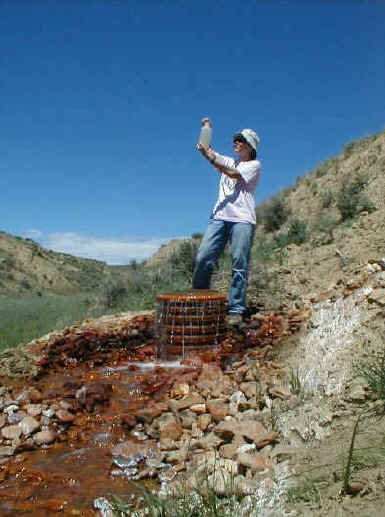
Biogeochemistry of Carbon and Nitrogen in Aquatic Environments
Research Topics Index Project Home
Biogeochemistry of Coal Bed Methane (CBM) Discharge Water
Field Site: Burger Draw, Johnson Co., Wyoming
Introduction
Biological processes can have a profound impact on the quality of water.
Microbes, and to a lesser extent plants and animals, remove, add, or
transform solutes present in a water supply, thus altering the chemical
composition and the perceived utility of a particular water resource.
Often, those processes that have the greatest impact are
oxidation-reduction (redox) reactions because they can alter the water
solubility or the form (e.g., gaseous vs. ionic) of many chemical constituents.
Redox reactions are the fundamental
energy-generating processes for all living things.
Microorganisms are particularly versatile in their ability to catalyze
redox reactions and can grow on a wide range of redox couples (i.e., different
oxidants and reductants). For this reason, microbes are often important mediators of
biogeochemical change, especially when reduced waters enter oxidized
environments, or vice versa. Microbes
establish themselves at such boundaries and significantly enhance the
alterations that occur in the chemistry of the water.
Water obtained from subsurface,
saturated coal beds typically contains many kinds of reduced chemical
constituents. Besides methane,
these can include, hydrogen, ferrous iron, hydrogen sulfide, ammonium, and high
concentrations of particulate and dissolved organic carbon.
When this water is pumped for recovery of methane and then discharged on
the land surface, it is abruptly subjected to an oxidizing environment,
entraining molecular oxygen from the atmosphere.
The simultaneous presence of oxygen and the multitude of reductants from
the subsurface is a kind of disequilibrium paradise for many types of microbes.
It is highly likely that a variety of microbially mediated redox
reactions will be established in such an environment and that the net effect of
these processes will be a substantial alteration in the chemical composition of
the water at locations down-gradient in the flow path.
Objectives
The purposes of this study are to document the changes in solute composition of discharged coal bed methane (CBM) water along selected flow paths and to quantify and characterize the biogeochemical process(es) responsible for the predominant changes. It is anticipated that there will be significant differences in the processes that occur along two different types of flow paths. The first is the stream channel flow path; the second is the recharge flow path in which water moves downward to the water-table aquifer. The goal of this study is to examine both flow paths. The processes that occur along each flow path are being considered within the relevant biological, hydrological and geochemical contexts of each environment. Water and solute load budgets are being constructed for each flow path and interpreted within the context of natural recharge.
|
Collaborators: Richard W. Healy, USGS, Lakewood, Colo. Tim Bartos, USGS, Cheyenne, Wyo. Alan Schultz, BLM, Buffalo, Wyo. Myron Brooks, USGS, Cheyenne, Wyo. |
Links: |
CBM discharge into Burger Draw tributary, May 2002. |

Outfall of CBM discharge illustrating heavy staining from Iron oxides, May 2002. |
| Projects Index Top of Page |
| Return
to Biogeochemistry
of Carbon and Nitrogen in Aquatic Environments Home Page
USGS Home Page | USGS Water Resources | USGS Toxics Hydrology Program | USGS NRP | |